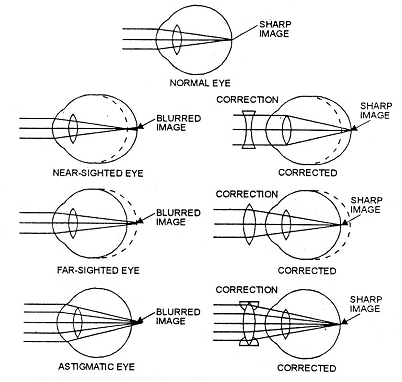COMMON EYE DEFECTS -
1. Glaucoma - Pressure of aquous humour is increased, retina is degenerated.
2. Presbyopia - Due to non etastic cilliary muscles, image of far and near place is not clear, generally it takes place in old age. Bifocal lens is used.
3. Toris - Upper eye lid is hanged down due to weakness of muscles.
4. Irtis - Due to inflamation of iris
5. Ophthalmitis - Inflamation of iris & cilliary body.
6. Trichoma - Mainly responsible for blindness. Under eye lids granules are formed. Caused by Chlomidia trachomatis.
7. Far sightedness or Long sightedness or Hypermetropia - Diameter of eye ball is reduced. Object of far distance can be seen clearly. Near objects are not seen clearly. Focal point is formed behind retina convex lens is used. Jaeger's chart is related to it.

8. Near sightedness or myopia - Diameter of eye ball is increased. Near objects can be seen clearly. Far objects are not seen clearly. Focal point is formed before ratina. Concave lens is used. Smellen's chart is related to it.
9. Ptosis - Falling or droping of eye lids.
10. Colour blindness - Ishihara's chart is related to it.